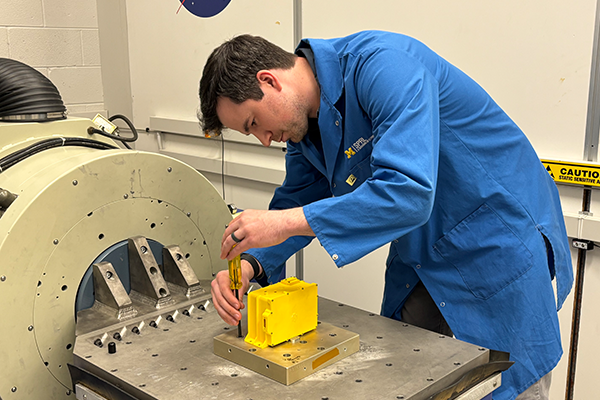
Space Physics Q&A: An Interview with Engineer in Research Lead Louis Marr
Louis Marr works as an Engineer in Research Lead for the Space Physics Research Laboratory (SPRL). In this Q&A, he shares some of his notable work at SPRL.

Louis Marr works as an Engineer in Research Lead for the Space Physics Research Laboratory (SPRL). In this Q&A, he shares some of his notable work at SPRL.
Hailing from Ann Arbor, Michigan, Louis Marr works as an Engineer in Research Lead for the Space Physics Research Laboratory (SPRL). He earned a bachelor’s degree in Mechanical Engineering from the University of Michigan. After he joined SPRL, he was able to combine his passion for aerospace with his skills in engineering.
Q. What is your research area or engineering focus?
A. My primary focus is on high voltage systems, particularly power supplies and mass spectrometers. That said, mechanical engineering is the Swiss Army knife of disciplines, so I’m frequently pulled in many directions—from electronic housing and structural design, to thermal, electrostatic and EMI analysis, as well as hands-on fabrication and manufacturing support.
Q. How did you decide to pursue this line of work, type of engineering, or area of research?
A. I’ve always been passionate about aerospace, and the chance to live in Ann Arbor while pursuing a career in the industry felt like a home run. My specific interest in high voltage systems really took off thanks to the mentorship of Ken Arnett and Steve Battel. Working with them opened my eyes to the complexity and excitement of this field, and it quickly became the most rewarding part of my work.

Q. Tell us more about your work. Could you give an example of a noteworthy project, instrument, lab, or study you have worked with?
A. Two of my favorite projects have been SPICES (Solar wind Pickup Ion Composition Energy Spectrometer) and SWFC (Space Weather Faraday Cup). Both have involved a fascinating interplay of structural, thermal, and electrostatic design challenges. These factors often conflict, yet none can be compromised if we want to maximize scientific performance. Developing these instruments feels like a constant dance of trade studies and subsystem testing—where the process is just as fulfilling as the final product.
Q. What is one of the greatest benefits or opportunities that have come from working in your field?
A. Aerospace offers a rare opportunity to add cutting-edge technologies into highly specialized design challenges. Working in a research setting amplifies this by giving you the freedom to explore advancements across other industries, and then apply those innovations to your own work. It’s this cross-pollination of ideas that keeps the work exciting and forward-thinking.
Q. When you think about your experience so far at the University of Michigan and SPRL, what gives you the most pride?
A. Growing up in Ann Arbor and being a lifelong Michigan fan, working for the University of Michigan has been a dream come true. It’s incredibly rewarding to contribute to the culture of excellence here—especially through meaningful research and mentoring students in the same College of Engineering I recently graduated from. On top of that, supporting emerging aerospace startups in Southeast Michigan has been fulfilling, and I hope to play a small part in helping Michigan become a serious player in the aerospace industry.
Q. What is the most important lesson you have learned along the way?
A. While the idea of not fearing failure is often repeated, what’s more important is being willing and prepared to learn from it. Growth doesn’t come just from failing—it comes from honest self-reflection and the humility to recognize what went wrong and how to improve. That mindset is what drives real progress.
Q. As you look to the future, what goals or career plans do you have in mind?
A. My overarching goal is to help the University of Michigan Space Physics Research Lab fly a groundbreaking heliophysics-focused mass spectrometer—one designed, developed, and built right here in Ann Arbor. We have the people, the expertise, and the infrastructure to make it happen. If I can play a central role in bringing that vision to life, it would be a career milestone worth celebrating—at least for a little while.